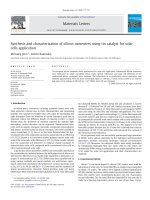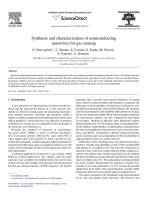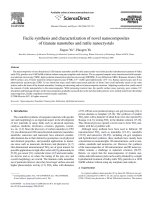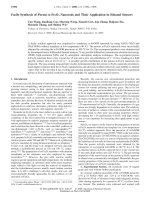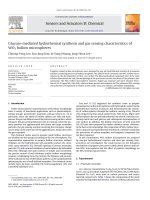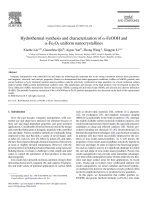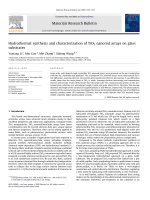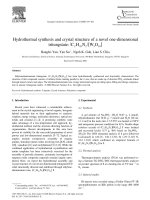- Trang chủ >>
- Khoa Học Tự Nhiên >>
- Vật lý
hydrothermal synthesis and characterization of - feooh and fe2o3 uniform nanocrystallines
Bạn đang xem bản rút gọn của tài liệu. Xem và tải ngay bản đầy đủ của tài liệu tại đây (957.51 KB, 5 trang )
Journal of Alloys and Compounds 433 (2007) 216–220
Hydrothermal synthesis and characterization of ␣-FeOOH and
␣-Fe
2
O
3
uniform nanocrystallines
Xiaohe Liu
a,b
, Guanzhou Qiu
b
, Aiguo Yan
b
, Zhong Wang
a
, Xingguo Li
a,∗
a
College of Chemistry & Molecular Engineering, Peking University, Beijing 100871, People’s Republic of China
b
Department of Inorganic Materials, Central South University, Changsha, Hunan 410083, People’s Republic of China
Received 18 April 2006; received in revised form 4 June 2006; accepted 6 June 2006
Available online 24 July 2006
Abstract
Inorganic nanoparticles with controlled size and shape are technologically important due to the strong correlation between these parameters
and magnetic, electrical, and catalytic properties. Herein we demonstrated that under appropriate conditions, rodlike ␣-FeOOH (goethite) and
porous fusiform ␣-Fe
2
O
3
(hematite) uniform nanocrystallines could be selectively synthesized in large quantities via a facile surfactant sodium
dodecyl sulfate (SDS) assisted hydrothermal synthetic route. The morphology and structure of the final products were investigated in detail by
X-ray diffraction (XRD), transmission electron microscopy (TEM), scanning electron microscopy (SEM), and selected area electron diffraction
(SAED). The probable formation mechanism of the ␣-FeOOH and ␣-Fe
2
O
3
uniform nanoparticles was discussed on the basis of the experimental
results.
© 2006 Elsevier B.V. All rights reserved.
Keywords: Hydrothermal; Porous; ␣-FeOOH; ␣-Fe
2
O
3
; Nanocrystallines
1. Introduction
Over the past decades, inorganic nanoparticles with con-
trolled size and shape have attracted vast attention because of
their size and shape-dependent properties and great potential
applications. Considerable effort has been devoted to the design
and controlled fabrication of inorganic materials with controlled
size and shape. Various synthetic methods are continually being
improved to this end. Recently a variety of novel shapes such
as tubes [1], rods [2], wire [3], belts [4], prisms [5], and cubes
[6] have been reported through chemical reactions of precursors
at room or slightly elevated temperatures. However, with the
growing interest in building advanced materials using nanoscale
building blocks, it remain a challenge to find simple and mild
routes to control the parameters of final products to fine-tune
their properties.
Iron oxides have attracted enormous attention owing to their
interesting electrical [7], magnetic [8], and catalytic [9] proper-
ties and wide variety of potential applications in various fields
∗
Corresponding author. Tel.: +86 10 62765930; fax: +86 10 62765930.
E-mail address: (X. Li).
such as electro-optic materials [10], sorbents [11], pigments
[12], ion exchangers [13], and magnetic resonance imaging
(MRI) [14], particularly in the field of catalysis [15]. Amongst
the readily available carbon monoxide oxidation catalysts, iron
oxide-based materialshave beenfound tobe especiallyattractive
candidates as cheap and efficient catalysts [16]. Various pro-
cedures including wet chemical [17–20], electrochemical [21],
thermal decomposition techniques [22], and chemical oxidation
in polymer [23] have been successfully employed for the syn-
thesis of iron oxides nanocrystallines. As is well known, the
properties of iron oxides nanocrystallines sensitively depend on
their size and shape. In order to improve the functional proper-
ties such as catalytic activity, it is significant challenge to control
the size and shape of iron oxides nanocrystallines. Porous iron
oxides nanoparticles may provide some immediate advantages
over their solid counterparts because of their relatively low den-
sities and large surface areas for their applications. In recent
years, Oca
˜
na and co-workers have synthesized uniform iron
oxides nanoparticles via aerial oxidation and forced hydroly-
sis methods [24], however, the products of such synthesis often
involved complicated process or produced in low quantities.
In this paper, we demonstrated that rodlike goethite (␣-
FeOOH) and porous fusiform hematite (␣-Fe
2
O
3
) iron oxide
0925-8388/$ – see front matter © 2006 Elsevier B.V. All rights reserved.
doi:10.1016/j.jallcom.2006.06.029
X. Liu et al. / Journal of Alloys and Compounds 433 (2007) 216–220 217
uniform nanocrystallines could be selectively synthesized
through a facile hydrothermal synthetic route in large quantities
under mild conditions. When only prolonging the hydrothermal
time from 12 to 24 h, the rodlike ␣-FeOOH nanocrystallines
could be transfered to porous fusiform ␣-Fe
2
O
3
nanocrys-
tallines. In this synthetic system, surfactant sodium dodecyl
sulfate (SDS) was used as a structure-directing agent, and simple
compounds of the hydrated ferrous chloride and sodium boro-
hydride as reactants directly. The high yields, simple reaction
apparatus and low reaction temperature give this novel method
a good prospect in the future applications.
2. Experimental
All chemicals in this work, such as hydrated ferrous chloride (FeCl
2
·4H
2
O),
sodium borohydride (NaBH
4
), and sodium dodecyl sulfate (SDS) were of ana-
lytical grade, and which were used without further purification.
2.1. Preparation of iron oxides nanocrystallines
In a typical procedure, pure sodium dodecyl sulfate (0.001 mol) and hydrated
ferrous chloride (FeCl
2
·4H
2
O, 0.001 mol) were firstly dissolved in distilled
water to form a salmon pink micellar solution under vigorous stirring at room
temperature. Then, sodium borohydride solution (NaBH
4
, 0.5 mmol) was added
to the salmon pink solution. With the introduction of sodium borohydride solu-
tion, the color of mixed micellar solution turned immediately from salmon pink
to black. Next, the mixture was transferred to a Teflon-lined stainless steel auto-
clave of 50 mL capacity. Finally, the autoclave was filled with distilled water
up to 75% of the total volume, sealed and maintained at 140
◦
C for 4, 8, 12,
and 24 h, respectively. After the heating treatment, the autoclave was allowed to
cool down to room temperature naturally. The resulting products were filtered,
washed with distilled water and absolute ethanol, and finally dried in vacuum at
50
◦
C for 6 h.
2.2. Characterization
The rodlike ␣-FeOOH (goethite) and porous fusiform ␣-Fe
2
O
3
(hematite)
nanocrystallines were characterized using various techniques. X-ray powder
diffraction (XRD) patterns were obtained on a Bruker D8-advance X-ray diffrac-
tometer with graphite-monochromatized Cu K␣ (λ = 1.54178
˚
A) radiation. The
operation voltage and current were kept at 40 kV and 40 mA, respectively. TEM
patterns were recorded on a Hitachi Model H-800 transmission electron micro-
scope at an accelerating voltage of 200 kV. The samples were dispersed in
absolute ethanol in an ultrasonic bath. Then the suspensions were dropped onto
Cu grids coated with amorphous carbon films. Selected area electron diffraction
(SAED) was further performed to identify the crystallinity. The scanning elec-
tron microscopic (SEM) images were obtained using a LEO 1530 field-emission
scanning electron microscope (FE-SEM), under typical working conditions of
10 kV.
3. Results and discussion
Fig. 1 shows typical X-ray diffraction (XRD) patterns (2θ
scan) of the goethite (␣-FeOOH) iron oxide nanocrystallines
obtained at 140
◦
C for different reaction time. All the reflections
of the XRD pattern can be finely indexed to an orthorhombic
phase [space group: Pbnm(62)] of ␣-FeOOH with cell param-
eters a = 4.64
˚
A, b = 10.0, c = 3.03
˚
A (JCPDS file Card, No. 03-
0249). The XRD patterns of Fig. 1 from a to c correspond to the
goethite (␣-FeOOH) iron oxide nanocrystallines obtained for 4,
8, and 12 h, respectively. The XRD pattern (Fig. 1a) of sample
shows that the goethite (␣-FeOOH) iron oxide nanocrystallines
Fig. 1. The evolution of the XRD patterns of the ␣-FeOOH nanocrystallines
obtained at 140
◦
C for different reaction time: (a) 4 h; (b) 8 h; (c) 12 h. (
*
␣-
Fe
2
O
3
).
obtained for 4 h were poorly crystallized. With the elongation of
reaction time, the XRD patterns of samples at the whole process
show that the crystallinities of the samples were continuously
improved. When the samples maintained for 8 h, the XRD pat-
tern of the sample is shown in Fig. 1b. The main diffraction
peaks of ␣-FeOOH are clear observed in the patterns. When
the reaction time prolonged to 12 h (in Fig. 1c), the peaks of
␣-FeOOH become slightly weak, along with the weakening of
␣-Fe
2
O
3
peaks, which indicates the transition from ␣-FeOOH
to ␣-Fe
2
O
3
.
Fig. 2 shows the X-ray diffraction pattern of the sample
of hematite (␣-Fe
2
O
3
) iron oxide nanocrystallines that were
obtained at 140
◦
C for 24 h. The composition could be expressed
as rhombohedral phase ␣-Fe
2
O
3
[space group: R
¯
3c(167)] with
lattice constants a = 5.0356, c = 13.7489 (JCPDS file Card, No.
33-0664), since the main diffraction peaks of rhombohedral
phase ␣-Fe
2
O
3
, 012, 104, 110, 113, 024, 116, 018, 214, and
300, are clearly observed in the patterns. No impurity peaks are
Fig. 2. The XRD pattern of the porous fusiform ␣-Fe
2
O
3
nanocrystallines
obtained at 140
◦
C for 24 h.
218 X. Liu et al. / Journal of Alloys and Compounds 433 (2007) 216–220
Fig. 3. (A) TEM image of the sample produced at 140
◦
C for 4 h. (B) TEM image of the sample produced at 140
◦
C for 8 h. The insets of (A and B) show the SAED
pattern of the rodlike ␣-FeOOH nanocrystallines taken on a mass of ␣-FeOOH nanocrystallines.
observed, indicating the hematite (␣-Fe
2
O
3
) iron oxide success-
fully synthesized under current experimental conditions.
The size and morphology of the rodlike ␣-FeOOH (goethite)
and porous fusiform ␣-Fe
2
O
3
(hematite) nanocrystallines were
further examined by transmission electron microscopy (TEM).
Fig. 3A shows the typical TEM photograph of ␣-FeOOH
nanocrystallines obtained at 140
◦
C for 4 h through a surfac-
tant SDS assisted hydrothermal synthetic route, and its select
area electron diffraction pattern indicates the sample A is poorly
crystallized, being in good agreement with the XRD patterns. In
contrast to the sample processed for 4 h, the sample prepared
at 140
◦
C for 8 h is mostly rodlike form, as can be observed
more clearly from Fig. 3B. The inset showing a select area elec-
tron diffraction pattern of the rodlike ␣-FeOOH nanocrystallines
taken on a mass of ␣-FeOOH nanorods reveals the satisfactory
crystallinity of the sample, which can be indexed to the pure
Fig. 4. TEM image of the sample of produced at 140
◦
C for 12 h. (B) TEM image of the sample produced at 140
◦
C for 24 h. The inset shows the SAED pattern of
the individual fusiform ␣-Fe
2
O
3
(hematite) nanocrystallines.
X. Liu et al. / Journal of Alloys and Compounds 433 (2007) 216–220 219
Fig. 5. (A) Low- and (B) high-magnification SEM images of the fusiform ␣-Fe
2
O
3
nanocrystallines synthesized with the surfactant SDS process at 140
◦
C for 24 h.
orthorhombic phase of goethite ␣-FeOOH. When the reaction
time prolonged to 12 h, the previous nanorods appeared agglom-
erate (in Fig. 4A), which is very critical for the formation of
porous fusiform ␣-Fe
2
O
3
(hematite) nanocrystallines. Fusiform
␣-Fe
2
O
3
(hematite) nanocrystallines were obtained when the
reactants were treated at 140
◦
C for 24 h, as shown in Fig. 4B.
TEM observations indicates that about 100% of the products are
fusiform ␣-Fe
2
O
3
nanocrystallines whose diameter ranges from
about 50 to 70 nm with a length of up to ∼200 nm. There was an
interesting change in the morphology of the sample of ␣-Fe
2
O
3
nanocrystallines. With careful observation, the fusiform ␣-
Fe
2
O
3
nanocrystallines can be made up from many porous struc-
tures. The inset is an electron diffraction pattern of an individual
fusiform ␣-Fe
2
O
3
nanocrystallines, which can be indexed to
rhombohedral phase of hematite ␣-Fe
2
O
3
and exhibits that each
porous fusiform ␣-Fe
2
O
3
nanocrystalline was a single crystal.
Fig. 5A and B shows scanning electron microscope images of
a typical sample of fusiform ␣-Fe
2
O
3
nanocrystallines obtained
at 140
◦
C for 24 h and indicate the large quantity and good
uniformity ␣-Fe
2
O
3
nanocrystallines were achieved using this
approach. These fusiform ␣-Fe
2
O
3
nanocrystallines have a
mean diameter of 60 nm and length of up to ∼200 nm, which
agree well with the TEM results. Fig. 5B is a higher magnifi-
cation SEM image obtained from a selected area of Fig. 5A.
Herein, fusiform ␣-Fe
2
O
3
nanocrystallines with many porous
structures can be clearly observed. The chemical compositions
of the as-prepared fusiform ␣-Fe
2
O
3
nanocrystallines have been
investigated by means of EDS. Results from EDS spectra (Fig. 6)
show that the fusiform ␣-Fe
2
O
3
nanocrystallines contain Fe and
O, and no contamination elements are detected. The atomic ratio
of Fe and O matched their stoichiometries quite well.
Associating all those results, the whole reaction to form the
␣-FeOOH and ␣-Fe
2
O
3
uniform nanoparticles can be expressed
as the following equation:
4Fe
2+
+ BH
4
−
+ 3H
2
O → 4Fe ↓+H
3
BO
3
+ 7H
+
(1)
Fe + 2H
+
→ Fe
2+
+ H
2
↑ (2)
4Fe
2+
+ O
2
+ 6H
2
O → 4FeOOH ↓+8H
+
(3)
2FeOOH → Fe
2
O
3
↓+H
2
O (4)
Soluble ferrous chlorides will firstly dissociate in water into fer-
rous ions, which then react with sodium borohydride to form
ultrafine iron particles. The reduction of transition metal ions
for the production of ultrafine metal particles by BH
4
−
is a
ubiquitous reaction. The ultrafine iron particles may be redis-
solved under acidic conditions. Subsequently, rodlike ␣-FeOOH
(goethite) nanocrystallines will gradually form under surfactant
SDS assisted hydrothermal conditions. With the reaction time
prolonged, rodlike ␣-FeOOH nanocrystallines appear agglom-
erate and form fusiform nanocrystallines. Finally, the ␣-FeOOH
Fig. 6. The EDS spectra of the as-prepared porous fusiform ␣-Fe
2
O
3
nanocrys-
tallines.
220 X. Liu et al. / Journal of Alloys and Compounds 433 (2007) 216–220
nanocrystallines maybe dehydrate and form porous fusiform ␣-
Fe
2
O
3
nanocrystallines.
4. Conclusion
In summary, we have successfully synthesized the rodlike
goethite (␣-FeOOH) and porous fusiform hematite (␣-Fe
2
O
3
)
iron oxide uniform nanocrystallines via a facile surfactant
sodium dodecyl sulfate assisted hydrothermal synthetic route
at mild conditions. The influence of reaction time on size and
shape was investigated. Results show the hydrothermal time was
dominant. When maintained at 140
◦
C for 4 h, the sample of
goethite (␣-FeOOH) iron oxide is poorly crystallized, however,
the sample of ␣-FeOOH prepared at 140
◦
C for 8 h is mostly
nanorodlike form with satisfactory crystallinity. With increas-
ing the hydrothermal time, goethite (␣-FeOOH) iron oxide
nanorods appeared agglomerate, and a part of the ␣-FeOOH
phase transformed to ␣-Fe
2
O
3
phase. When the reaction time
prolonged to 24 h, we successfully synthesized porous fusiform
hematite (␣-Fe
2
O
3
) iron oxide nanocrystallines with good uni-
formity. The synthetic strategy presented here may have a good
prospect in the future application and provide an effective route
to synthesize other metal oxide nanocrystallines. Owing to the
excellent physical properties of the iron oxides, it is expected
the rodlike ␣-FeOOH (goethite) and porous fusiform ␣-Fe
2
O
3
(hematite) uniform nanocrystallines exhibit some important
applications in, e.g., sensors, magnetic media, catalytic fields,
etc.
Acknowledgements
Financial support of this work by National Natural Science
Foundation of China (Grant no. 50504017) and Hunan Provin-
cial Natural Science Foundation of China (Grant no. 05JJ30104)
is gratefully acknowledged.
References
[1] O.Y. Min, J L. Huang, C.L. Cheung, C.M. Lieber, Science 292 (2001) 702.
[2] X.H. Liu, Mater. Chem. Phys. 91 (2005) 212.
[3] H. Yu, J. Li, R.A. Loomis, L W. Wang, W.E. Buhro, Nat. Mater. 2 (2003)
517.
[4] X.Y. Kong, Y. Ding, R.S. Yang, Z.L. Wang, Science 303 (2004) 1348.
[5] R.C. Jin, Y.C. Cao, E. Hao, G.S. M
´
etraux, G.C. Schatz, C.A. Mirkin, Nature
425 (2003) 487.
[6] F. Dumestre, B. Chaudret, C. Amiens, P. Renaud, P. Fejes, Science 303
(2004) 821.
[7] M.F. Haquea, S. Arajs, Int. J. Heat Mass Transfer 42 (1999) 1617.
[8] Y. Einaga, M. Taguchi, G.M. Li, T. Akitsu, Z.Z. Gu, T. Sugai, O. Sato,
Chem. Mater. 15 (2003) 8.
[9] D.N. Srivastava, N. Perkas, A. Gedanken, I. Felner, J. Phys. Chem. B 106
(2002) 1878.
[10] S. Miteva, M. Stoimenova, J. Colloid Interface Sci. 273 (2004) 490.
[11] D.S. Toledano, V.E. Henrich, J. Phys. Chem. B 105 (2001) 3872.
[12] U. Shwertmann, R.M. Cornell, Iron Oxides in the Laboratory, VCH, New
York, 1991.
[13] A.W. Apblett, S.I. Kuriyavar, B.P. Kiran, J. Mater. Chem. 13 (2003) 983.
[14] L. Babes, B. Denizot, G. Tanguy, J.J. Le Jeune, P. Jallet, J. Colloid Interface
Sci. 212 (1999) 474.
[15] Q. Fu, S.M. Huang, J. Liu, J. Phys. Chem. B 108 (2004) 6124.
[16] Z.Y. Yuan, T.Z. Ren, B.L. Su, Catal. Today 93 (2004) 743.
[17] Y.S. Kang, S. Risbud, J.F. Rabolt, P. Stroeve, Chem. Mater. 8 (1996) 2209.
[18] M. Oc
˜
ana, M.P. Morales, C.J. Serna, J. Colloid Interface Sci. 212 (1999)
317.
[19] Z. Jiang, S. Wu, Mater. Lett. 58 (2004) 3637.
[20] Z. Jing, S. Wu, S. Zhang, W. Huang, Mater. Res. Bull. 39 (2004) 2057.
[21] C. Pascal, J.L. Pascal, F. Favier, M.L.E. Moubtassim, C. Payen, Chem.
Mater. 11 (1999) 141.
[22] J. Cheon, N J. Kang, S M. Lee, J H. Lee, J H. Yoon, S.J. Oh, J. Am.
Chem. Soc. 126 (2004) 1950.
[23] R. Ziolo, E.P. Giannelis, B.A. Weinstein, M.P. O’Horo, B.N. Ganguly, V.
Mehrotra, M.W. Russel, D.R. Huffman, Science 257 (1992) 219.
[24] R. Pozas, M. Oca
˜
na, M.P. Morales, C.J. Serna, J. Colloid Interface Sci. 254
(2002) 87.
